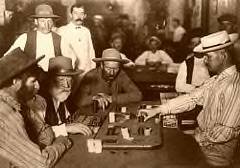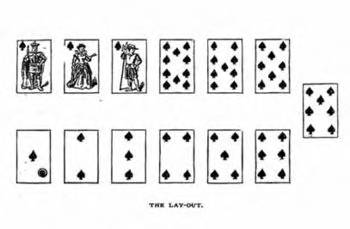Faro (card game) from Wikipedia
| Faro, Pharaoh, or Farobank, is a late 17th century French
gambling card game descendant of basset, and belongs to the lansquenet
and Monte Bank family of games, in that it is played between a banker and
several players winning or losing according to the cards turned up matching
those already exposed or not.
Although not a direct relative of poker, faro was played
by the masses alongside its other popular counterpart, due to its fast
action, easy-to-learn rules, and better odds than most games of chance.
The game of faro is played with only one deck of cards and allows for any
number of players, usually referred to as "punters".
History
France |

playing faro in an Arizona saloon
in 1895. |
The earliest references to a card game named pharaon are
found in Southwestern France in the late 17th century (1688) during the
reign of Louis XIV.
England
Pharaoh and basset, the most popular card games of 18th
and 19th century Europe, were forbidden in France during the reign of Louis
XIV on severe penalties, but these games continued to be widely played
in England during the 18th century. Pharo, the English alternate spelling
of Pharaoh, was easy to learn, quick and, when played honestly, the odds
for a player were the best of all gambling games, as records Gilly Williams
in a letter to George Selwyn in 1752.
United States
With its name shortened to faro, it soon spread to the
United States in the 19th century to become the most widespread and popularly
favored gambling game. Also called "Bucking the Tiger", which comes from
early card backs that featured a drawing of a Bengal Tiger, it was played
in almost every gambling hall in the Old West from 1825 to 1915.
Faro's detractors regarded it as a dangerous scam that
destroyed families and reduced men to poverty because of rampant rigging
of the dealing box. Crooked faro equipment was so popular that many sporting-house
companies began to supply gaffed dealing boxes specially designed so that
the bankers could cheat their players. Cheating was prevalent enough that
editions of Hoyle’s Rules of Games began their faro section warning readers
that not a single honest faro bank could be found in the United States.
While the game became scarce after World War II, it continued to be played
at a few Las Vegas and Reno casinos through 1985.
Etymology
Historians have suggested that the name Pharaon comes
from Louis XIV's royal gamblers who called the game pharaon because of
the motif that commonly adorned one of the French-made court cards. Another
idea traces the name to the Irish word fairadh, pronounced "fearoo", meaning
"to turn". It could have been brought to England and France through the
mass emigration from Ireland, in particular in the aftermath of the Flight
of the Wild Geese. Also the Irish Brigade served in France and may have
brought the term with them.
Rules

The layout of a faro board. |
Description
A game of faro was often called a "faro bank". It was
played with an entire deck of playing cards. One person was designated
a "banker" and an indeterminate number of players could be admitted. Chips
(called "checks") were purchased by the punter from the banker (or house)
from which the game originated. Bet values and limits were set by the house.
Usual check values were 50 cents to $10 each.
The faro table was oval, covered with green baize, and
had a cutout for the banker. A board with a standardized betting layout
consisting of one card of each denomination pasted to it, called the "layout",
was placed on top of the table. Traditionally, the suit of spades was used
for the layout. Each player laid his stake on one of the 13 cards on the
layout. Players could place multiple bets and could bet on multiple cards
simultaneously by placing their bet between cards or on specific card edges.
Players also had the choice of betting on the “high card” bar located at
the top of the layout.
Procedure
| A deck of cards was placed face-up inside a "dealing
box", a mechanical shoe used to prevent manipulations of the draw by the
banker and intended to ensure players of a fair game.
The first card in the dealing box is called the "soda"
and is "burned" off, leaving 51 cards in play. As the soda is pulled out
of the dealing box, it exposes the first card in play, called the "banker's
card". This is placed on the right side of the dealing box. The next card
exposed after the banker's card is called the carte Anglaise (English card)
or simply the "player's card", and it is placed on the left.
The banker's card is the "losing card". All bets placed
on that card are lost by the players and won by the bank. The player's
card is the "winning card". All bets placed on that card are returned to
the players with a 1 to 1 (even money) payout by the bank (e.g. a dollar
bet wins a dollar). A “high card” bet won if the player’s card had a higher
value than the banker’s card. The banker collects on all the money staked
on the card laid on the right, and he pays double the sums staked on those
on the card remaining on the left (in the dealing box). The dealer settles
all bets after each two cards drawn. This allows players to bet before
drawing the next two cards.
A player could "copper" his bet by placing a hexagonal
(6-sided) token called a "copper" on it. Some histories said a penny was
sometimes used in place of a copper. This reversed the meaning of the win/loss
piles for that particular bet. An abacus-like device, called a "case keep",
is employed to assist the players and prevent dealer cheating by counting
cards. The operator of the case keep is called the "case keeper".
|
French terms used in Faro
By 1870, the
words used in the game were a mixture of French and English words and spellings.
* Banker - The person who keeps the table.
* Taillèur (Dealer) - Generally the banker.
* Couche or Enjeu - The stake.
* Coup (a Stroke or Pull) - Any two cards dealt alternately
to the right and left.
* Croupier (Croup) - An assistant to the dealer
* Doublet - When the punter's card is turned up twice
in the same coup, then the bank wins half the stake. A single paroli must
be
taken down, but if there are
several, only one retires.
* Fasse - The first card turned up by the Banker, by
which he gained half the value of the money laid upon every card of that
sort by
the punters or players.
* Hocly - The last card but one, the chance of which
the banker claims, and may refuse to let any punter withdraw a card when
eight or
less remain to be dealt.
* Livret - A suit of 13 cards, with 4 others called Figures.
One named the little figure, has a blue cross on each side and represents
ace,
deuce, tray; another yellow
on both sides, styled the yellow figure, signifies, 4, 5, 6; a third with
a black lozenge in the centre, named
the black figure, stands for
7, 8, 9. 10; and a red card, called the great or red figure, for Jack,
Queen, King: those figures are useful for
those who punt on several cards
at once.
* L'une pour l'autre (One for the other) - Means a drawn
game, and is said when two of the punter's cards are dealt in the same
coup.
* Masque - Means turning a card, or placing another face
downwards, during any number of coups, on that whereon the punter has
staked, and which he may afterward
play at pleasure.
* Oppose - Reversing the game, and having the cards on
the right for the punter, and those on the left for the dealer.
* Pli (Bending) - Used when a punter, having lost half
his stake by a doublet, bends a card in the middle, and setting it up with
the
points and foot towards the
dealer, signifies thereby a desire either of recovering the moiety, or
of losing all.
* Ponte or Punt (Point) - The punter or player.
* Pont (Bridge) - The same as paix.
* Paix (Peace) - Equivalent to double or quits; that
is, when the punter having won, does not choose to paroli and risk his
stake, but
bends or makes a bridge of his
card, signifying that he ventures his gains only. A double paix is, when
the punter having won twice,
bends two cards one over the
other. Treble paix, thrice, etc. A paix may follow a seven, fifteen, or
thirty, etc.
* Paroli or Parolet-Double - Sometimes called cocking,
is when a punter, being fortunate, chooses to venture both his stake and
wins,
which he intimates by bending
a corner of his card upwards.
* Cocking - See Paroli.
* Paix-Paroli - When a punter has won a paroli, wishes
then to play double or quits, and save his original stake, which he shows
by
doubling a card after making his first
paroli; double-paix-paroli succeeds to winning a paix-paroli; treble-paix-paroli
follows double,
etc.
* Sept et le Va (Seven and it goes) - Succeed the winning
of a paroli, by which the punter being entitled to triple his stake, risks
the
whole again, and, bending his card
a second time, tries to win seven-fold.
* Quinze et le Va (Fifteen and it goes) - When the punter
having won a sept, &c., bends the third corner of the card, and ventures
for 15
times his stake.
* Trente et le Va (Thirty and it goes) - Follows a fifteen,
etc., when the punter again tries his luck, and makes a fourth paroli.
* Soitraitte et le Va (Sixty and it goes) - When the
player having obtained a thirty, ventures all once more, which is signified
by making
a fifth paroli, either on another
card, if he has parolied on one only before, or by breaking the side of
that one which contains four, to
pursue his luck in the next deal. |
|